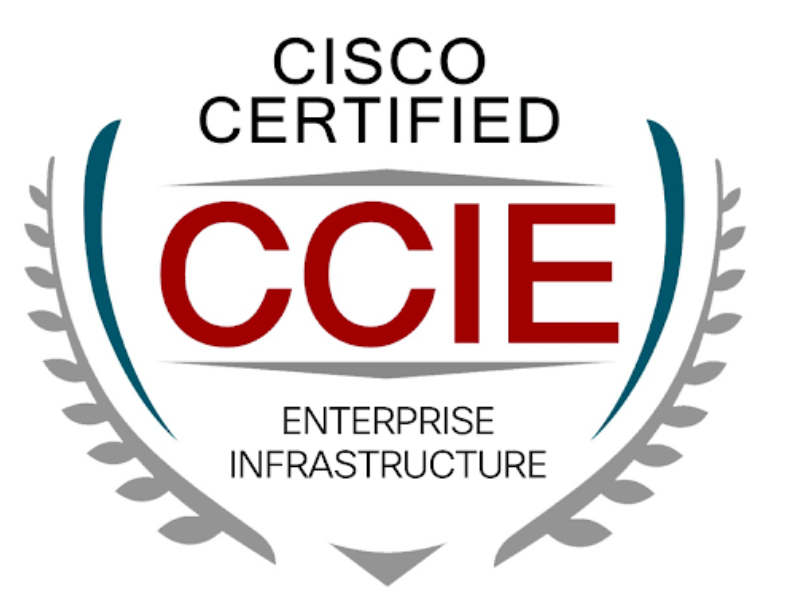CCIE EI考试大纲
CCIE Enterprise Infrastructure Exam Topics - Practical Exam

-
1.1 Switched campus
- 1.1.a Switch administration
- 1.1.a i Managing MAC address table
- 1.1.a ii Errdisable recovery
- 1.1.a iii L2 MTU
- 1.1.b Layer 2 protocols
- 1.1.b i CDP, LLDP
- 1.1.b ii UDLD
- 1.1.c VLAN technologies
- 1.1.c i Access ports
- 1.1.c ii Trunk ports (802.1Q)
- 1.1.c iii Native VLAN
- 1.1.c iv Manual VLAN pruning
- 1.1.c v VLAN database
- 1.1.c vi Normal range and extended range VLANs
- 1.1.c vii Voice VLAN
- 1.1.c viii VTP
- 1.1.d EtherChannel
- 1.1.d i LACP, static
- 1.1.d ii Layer 2, Layer 3
- 1.1.d iii Load balancing
- 1.1.d iv EtherChannel Misconfiguration Guard
- 1.1.e Spanning- Tree Protocol
- 1.1.e i PVST+, Rapid PVST+, MST
- 1.1.e ii Switch priority, port priority, path cost, STP timers
- 1.1.e iii PortFast, BPDU Guard, BPDU Filter
- 1.1.e iv Loop Guard, Root Guard
1.2 Routing Concepts
- 1.2.a Administrative distance
- 1.2.b VRF-lite
- 1.2.c Static routing
- 1.2.d Policy Based Routing
- 1.2.e VRF aware routing with any routing protocol
- 1.2.f Route filtering with any routing protocol
- 1.2.g Manual summarization with any routing protocol
- 1.2.h Redistribution between any pair of routing protocols
- 1.2.i Routing protocol authentication
- 1.2.j Bidirectional Forwarding Detection
1.3 EIGRP
- 1.3.a Adjacencies
- 1.3.b Best path selection
- 1.3.b i RD, FD, FC, successor, feasible successor
- 1.3.b ii Classic Metrics and Wide Metrics
- 1.3.c Operations
- 1.3.c i General operations
- 1.3.c ii Topology table
- 1.3.c iii Packet types
- 1.3.c iv Stuck In Active
- 1.3.c v Graceful shutdown
- 1.3.d EIGRP load-balancing
- 1.3.d i Equal-cost
- 1.3.d ii Unequal-cost
- 1.3.d iii Add-path
- 1.3.e EIGRP Named Mode
- 1.3.f Optimization, convergence and scalability
- 1.3.f i Fast convergence requirements
- 1.3.f ii Query propagation boundaries
- 1.3.f iii IP FRR (single hop)
- 1.3.f iv Leak-map with summary routes
- 1.3.f v EIGRP stub with leak map
1.4 OSPF (v2 and v3)
- 1.4.a Adjacencies
- 1.4.b Network types, area types
- 1.4.c Path preference
- 1.4.d Operations
- 1.4.d i General operations
- 1.4.d ii Graceful shutdown
- 1.4.d iii GTSM (Generic TTL Security Mechanism)
- 1.4.e Optimization, convergence and scalability
- 1.4.e i Metrics
- 1.4.e ii LSA throttling, SPF tuning, fast hello
- 1.4.e iii LSA propagation control (area types)
- 1.4.e iv Stub router
- 1.4.e v Loop-free alternate
- 1.4.e vi Prefix suppression
1.5 BGP
- 1.5.a IBGP and EBGP peer relationships
- 1.5.a i Peer-group/update-group, template
- 1.5.a ii Active, passive
- 1.5.a iii Timers
- 1.5.a iv Dynamic neighbors
- 1.5.a v 4-bytes AS numbers
- 1.5.a vi Private AS
- 1.5.b Path selection
- 1.5.b i Attributes
- 1.5.b ii Best path selection algorithm
- 1.5.b iii Load-balancing
- 1.5.c Routing policies
- 1.5.c i Attribute manipulation
- 1.5.c ii Conditional advertisement
- 1.5.c iii Outbound Route Filtering
- 1.5.c iv Standard and extended communities
- 1.5.c v Multi-homing
- 1.5.d AS path manipulations
- 1.5.d i local-AS, allowas-in, remove-private-as
- 1.5.d ii Prepend
- 1.5.d iii Regexp
- 1.5.e Convergence and scalability
- 1.5.e i Route reflector
- 1.5.e ii Aggregation, as-set
- 1.5.f Other BGP features
- 1.5.f i Multipath, add-path
- 1.5.f ii Soft reconfiguration, Route Refresh
1.6 Multicast
- 1.6.a Layer 2 multicast
- 1.6.a i IGMPv2, IGMPv3
- 1.6.a ii IGMP Snooping, PIM Snooping
- 1.6.a iii IGMP Querier
- 1.6.a iv IGMP Filter
- 1.6.a v MLD
- 1.6.b Reverse path forwarding check
- 1.6.c PIM
- 1.6.c i Sparse Mode
- 1.6.c ii Static RP, BSR, AutoRP
- 1.6.c iii Group to RP Mapping
- 1.6.c iv Bidirectional PIM
- 1.6.c v Source-Specific Multicast
- 1.6.c vi Multicast boundary, RP announcement filter
- 1.6.c vii PIMv6 Anycast RP
- 1.6.c viii IPv4 Anycast RP using MSDP
- 1.6.c ix Multicast multipath
-
2.0 Software Defined Infrastructure25%
2.1 Cisco SD Access
- 2.1.a Design a Cisco SD Access solution
- 2.1.a i Underlay network (IS-IS, manual/PnP)
- 2.1.a ii Overlay fabric design (LISP, VXLAN, Cisco TrustSec)
- 2.1.a iii Fabric domains (single-site and multi-site using SD-WAN transit)
- 2.1.b Cisco SD Access deployment
- 2.1.b i Cisco DNA Center device discovery and device management
- 2.1.b ii Add fabric node devices to an existing fabric
- 2.1.b iii Host onboarding (wired endpoints only)
- 2.1.b iv Fabric border handoff
- 2.1.c Segmentation
- 2.1.c i Macro-level segmentation using VNs
- 2.1.c ii Micro-level segmentation using SGTs (using Cisco ISE)
- 2.1.d Assurance
- 2.1.d i Network and client health (360)
- 2.1.d ii Monitoring and troubleshooting
2.2 Cisco SD-WAN
- 2.2.a Design a Cisco SD-WAN solution
- 2.2.a i Orchestration plane (vBond, NAT)
- 2.2.a ii Management plane (vManage)
- 2.2.a iii Control plane (vSmart, OMP)
- 2.2.a iv Data plane (vEdge/cEdge)
- 2.2.b WAN edge deployment
- 2.2.b i Onboarding new edge routers
- 2.2.b ii Orchestration with zero-touch provisioning/Plug-And-Play
- 2.2.b iii OMP
- 2.2.b iv TLOC
- 2.2.c Configuration templates
- 2.2.d Localized policies (only QoS)
- 2.2.e Centralized policies
- 2.2.e i Application Aware Routing
- 2.2.e ii Topologies
-
3.0 Transport Technologies and Solutions15%
3.1 MPLS
- 3.1.a Operations
- 3.1.a i Label stack, LSR, LSP
- 3.1.a ii LDP
- 3.1.a iii MPLS ping, MPLS traceroute
- 3.1.b L3VPN
- 3.1.b i PE-CE routing
- 3.1.b ii MP-BGP VPNv4/VPNv6
- 3.1.b iii Extranet (route leaking)
3.2 DMVPN
- 3.2.a Troubleshoot DMVPN Phase 3 with dual-hub
- 3.2.a i NHRP
- 3.2.a ii IPsec/IKEv2 using pre-shared key
- 3.2.a iii Per-Tunnel QoS
- 3.2.b Identify use-cases for FlexVPN
- 3.2.b i Site-to-site, Server, Client, Spoke-to-Spoke
- 3.2.b ii IPsec/IKEv2 using pre-shared key
- 3.2.b iii MPLS over FlexVPN
-
4.0 Infrastructure Security and Services15%
4.1 Device Security on Cisco IOS XE
- 4.1.a Control plane policing and p rotection
- 4.1.b AAA
4.2 Network Security
- 4.2.a Switch security features
- 4.2.a i VACL, PACL
- 4.2.a ii Storm control
- 4.2.a iii DHCP Snooping, DHCP option 82
- 4.2.a iv IP Source Guard
- 4.2.a v Dynamic ARP Inspection
- 4.2.a vi Port Security
- 4.2.a vii Private VLAN
- 4.2.b Router security features
- 4.2.b i IPv6 Traffic Filters
- 4.2.b ii IPv4 Access Control Lists
- 4.2.b iii Unicast Reverse Path Forwarding
- 4.2.c IPv6 infrastructure security features
- 4.2.c i RA Guard
- 4.2.c ii DHCP Guard
- 4.2.c iii Binding table
- 4.2.c iv Device tracking
- 4.2.c v ND Inspection/Snooping
- 4.2.c vi Source Guard
- 4.2.d IEEE 802.1X Port-Based Authentication
- 4.2.d i Device roles, port states
- 4.2.d ii Authentication process
- 4.2.d iii Host modes
4.3 System Management
- 4.3.a Device management
- 4.3.a i Console and VTY
- 4.3.a ii SSH, SCP
- 4.3.a iii RESTCONF, NETCONF
- 4.3.b SNMP
- 4.3.b i v2c
- 4.3.b ii v3
- 4.3.c Logging
- 4.3.c i Local logging, syslog, debugs, conditional debugs
- 4.3.c ii Timestamps
4.4 Quality of Service
- 4.4.a End to end L3 QoS using MQC
- 4.4.a i DiffServ
- 4.4.a ii CoS and DSCP Mapping
- 4.4.a iii Classification
- 4.4.a iv Network Based Application Recognition (NBAR)
- 4.4.a v Marking using IP Precedence, DSCP, CoS
- 4.4.a vi Policing, shaping
- 4.4.a vii Congestion management and avoidance
- 4.4.a viii HQoS, Sub-rate Ethernet Link
4.5 Network Services
- 4.5.a First-Hop Redundancy Protocols
- 4.5.a i HSRP, GLBP, VRRP
- 4.5.a ii Redundancy using IPv6 RS/RA
- 4.5.b Network Time Protocol
- 4.5.b i Master, client
- 4.5.b ii Authentication
- 4.5.c DHCP on Cisco IOS
- 4.5.c i Client, server, relay
- 4.5.c ii Options
- 4.5.c iii SLAAC/DHCPv6 interaction
- 4.5.c iv Stateful, stateless DHCPv6
- 4.5.c v DHCPv6 Prefix Delegation
- 4.5.d IPv4 Network Address Translation
- 4.5.d i Static NAT, PAT
- 4.5.d ii Dynamic NAT, PAT
- 4.5.d iii Policy-based NAT, PAT
- 4.5.d iv VRF aware NAT, PAT
- 4.5.d v IOS-XE VRF-Aware Software Infrastructure (VASI) NAT
4.6 Network optimization
- 4.6.a IP SLA
- 4.6.a i ICMP probes
- 4.6.a ii UDP probes
- 4.6.a iii TCP probes
- 4.6.b Tracking object
- 4.6.c Flexible Netflow
4.7 Network operations
- 4.7.a Traffic capture
- 4.7.a i SPAN
- 4.7.a ii RSPAN
- 4.7.a iii ERSPAN
- 4.7.a iv Embedded Packet Capture
- 4.7.b Cisco IOS-XE troubleshooting tools
- 4.7.b i Packet Trace
- 4.7.b ii Conditional debugger (debug platform condition)
-
5.0 Infrastructure Automation and Programmability15%
5.1 Data encoding formats
- 5.1.a JSON
- 5.1.b XML
5.2 Automation and scripting
- 5.2.a EEM applets
- 5.2.b Guest shell
- 5.2.b i Linux environment
- 5.2.b ii CLI Python module
- 5.2.b iii EEM Python module
5.3 Programmability
- 5.3.a Interaction with vManage API
- 5.3.a i Python requests library and Postman
- 5.3.a ii Monitoring endpoints
- 5.3.a iii Configuration endpoints
- 5.3.b Interaction with Cisco DNA Center API
- 5.3.b i HTTP request (GET, PUT, POST) via Python requests library and Postman
- 5.3.c Interaction with Cisco IOS XE API
- 5.3.c i Via NETCONF/YANG using Python ncclient library
- 5.3.c ii Via RESTCONF/YANG using Python requests library and Postman
- 5.3.d Deploy and verify model-driven telemetry
- 5.3.d i Configure on-change subscription using gRPC
本文出自 网络工程师培训、思科认证、华为认证培训-onelab网络实验室 ,原文链接:https://www.xacisco.net/44728 。如若转载请注明出处。
网络工程师交流群1

周一到周五晚7:30-8:30
免费公开直播课入群交流:
QQ群1:708776371

QQ扫码入群:

直播地址和直播录屏地址,腾讯课堂:
https://ke.qq.com/course/3383684?taid=11122071219446148&tuin=a3b1001c
联系我们
咨询华为认证培训,思科认证培训,微信添加:

微信咨询:hi20004 (可手动添加咨询)

微信咨询:hi20004 (可手动添加咨询)




